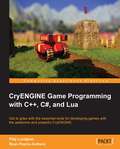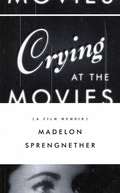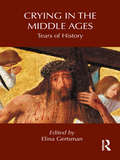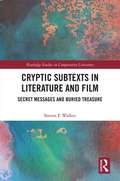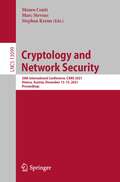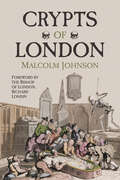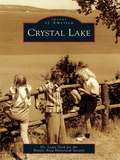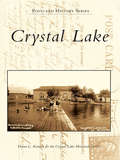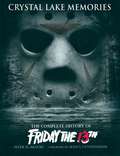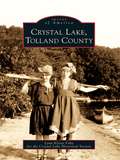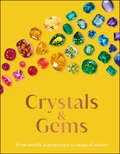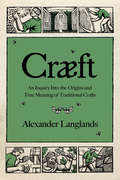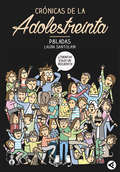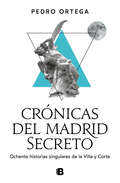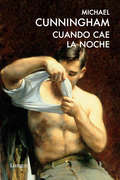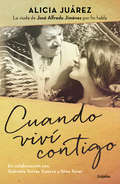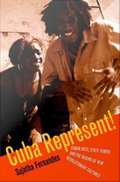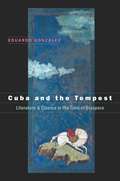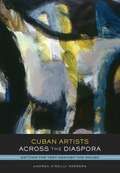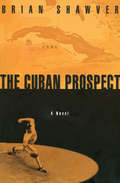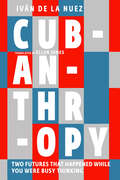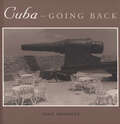- Table View
- List View
CryENGINE Game Programming with C++, C#, and Lua
by Filip Lundgren Ruan Pearce-AuthersThis book provides you with step-by-step exercises covering the various systems of CryENGINE and comprehensively explains their workings in a way that can be easily understood by readers of any skill level to help you develop your very own CryENGINE games.This book is intended for developers looking to harness the power of CryENGINE, providing a good grounding in how to use the engine to its full potential. The book assumes basic knowledge of the engine and its editor in non-programming areas.
Crying at the Movies: A Film Memoir
by Madelon Sprengnether"For years, I cried, not over my own losses, but at the movies. When bad things happened to me in real life, I didn't react. I seemed cool or indifferent. Yet in the dark and relative safety of the movie theater, I would weep over fictional tragedies, over someone else's tragedy."At age nine, Madelon Sprengnether watched her father drown in the Mississippi River. Her mother swallowed the family's grief whole and no one spoke of the tragedy thereafter. Only years later did Sprengnether react, and in a most unlikely place: in the theater watching the film Pather Panchali, by Satyajit Ray.In the fascinating memoir Crying at the Movies, Sprengnether looks at the sublime connections between happenings in the present, troubling events from the past, and the imagined world of movies. By examining the films she had intense emotional reactions to throughout her adult life--House of Cards, Solaris, Fearless, The Cement Garden, Shadowlands, and Blue--Sprengnether finds a way to work through her own losses, mistakes, and pain.
Crying in the Middle Ages: Tears of History (Routledge Studies in Medieval Religion and Culture)
by Elina GertsmanSacred and profane, public and private, emotive and ritualistic, internal and embodied, medieval weeping served as a culturally charged prism for a host of social, visual, cognitive, and linguistic performances. Crying in the Middle Ages addresses the place of tears in Jewish, Christian, and Islamic cultural discourses, providing a key resource for scholars interested in exploring medieval notions of emotion, gesture, and sensory experience in a variety of cultural contexts. Gertsman brings together essays that establish a series of conversations with one another, foregrounding essential questions about the different ways that crying was seen, heard, perceived, expressed, and transmitted throughout the Middle Ages. In acknowledging the porous nature of visual and verbal evidence, this collection foregrounds the necessity to read language, image, and experience together in order to envision the complex notions of medieval crying.
Cryptic Subtexts in Literature and Film: Secret Messages and Buried Treasure
by Steven F WalkerOne of the primary objectives of comparative literature is the study of the relationship of texts, also known as intertextuality, which is a means of contextualizing and analyzing the way literature grows and flourishes through inspiration and imitation, direct or indirect. When the inspiration and imitation is direct and obvious, the study of this rapport falls into the more restricted category of hypertextuality. What the author has labeled a cryptic subtext, however, is an extreme case of hypertextuality. It involves a series of allusions to another text that have been deliberately inserted by the author into the primary text as potential points of reference. This book takes a deep dive into a broad array of literature and film to explore these allusions and the hidden messages therein.
Cryptology and Network Security: 20th International Conference, CANS 2021, Vienna, Austria, December 13-15, 2021, Proceedings (Lecture Notes in Computer Science #13099)
by Mauro Conti Stephan Krenn Marc StevensThis book constitutes the refereed proceedings of the 20th International Conference on Cryptology and Network Security, CANS 2021, which was held during December 13-15, 2021. The conference was originally planned to take place in Vienna, Austria, and changed to an online event due to the COVID-19 pandemic.The 25 full and 3 short papers presented in these proceedings were carefully reviewed and selected from 85 submissions. They were organized in topical sections as follows: Encryption; signatures; cryptographic schemes and protocols; attacks and counter-measures; and attestation and verification.
Crypts of London: Past and Present
by Malcolm Johnson Richard LondinAfter the devastation of 1666, the Church of England in the City of London was given fifty-one new buildings in addition to the twenty-four that had survived the Great Fire. During the next hundred years others were built in the two cities of London and Westminster, most with a crypt as spacious as the church above. This book relates the amazing stories of these spaces, revealing an often surprising side to life – and death – inside the churches of historic London. The story of these crypts really began when, against the wishes of architects such as Wren and Vanbrugh, the clergy, churchwardens and vestries decided to earn some money by interring wealthy parishioners in their crypts. By 1800 there were seventy-nine church crypts in London, filled with the last remains of Londoners both illustrious and ordinary. Interments in inner London ended in the 1850s; since then, fifty-two crypts have been cleared, and five partially cleared – in each case resulting in the gruesome business of moving human remains. Today, many crypts have a new life as chapels, restaurants, medical centres and museums. With rare illustrations throughout, this fascinating study reveals the incredible history hidden beneath the churches of our capital. Malcolm Johnson is a retired priest, and has a PhD from King’s College, London. His well-received St Martin-in- the-Fields was published by Phillimore in 2005.
Crystal Lake
by Dr Louis Yock Benzie Area Historical SocietyAbout nine miles long and two miles wide, Crystal Lake has been a recreational center in northwest Michigan for over 100 years. However, resorts and vacations were not the intention of Benzonia's first settlers, who arrived on Crystal Lake's eastern shore in 1858 to found a religious colony and a college. In an attempt to increase the area's economic potential with a navigable channel to Lake Michigan, Crystal Lake was accidentally lowered in 1873. As the waters drained away, an unexpected boon occurred as summer camps, cottages, and resorts sprang up along its shores. The railroads and steamships were quick to follow with eager entrepreneurs, developers, and tourists. Between Frankfort and Point Betsie to the west, and Beulah to the east, an assortment of hideaways and getaways were established to cater to people of differing religions, occupations, and classes.
Crystal Lake (Postcard History)
by Crystal Lake Historical Society Diana L. KenneySince 1835, when Ziba Beardsley declared, "The water is as clear as crystal," generations of people have enjoyed the area's spring-fed lake. The pages of this book take readers on a trip back through time to learn more about the twin towns of Nunda and Crystal Lake and their eventual union. Meet some of Crystal Lake's first settlers, as well as those who came later, and discover how they shaped the community. See photographs and descriptions of summer resorts, country clubs, parks, schools, and churches. Trace the development of both Virginia Street and the historic downtown district through vintage street scenes. Some of the buildings shown in Crystal Lake were removed long ago, yet others are still standing to serve as silent reminders of the community's rich and proud heritage.
Crystal Lake Memories: The Complete History of Friday the 13th
by Peter M. BrackeWhen Friday the 13th premiered in 1980, the film introduced moviegoers to a new kind of cinematic terror - shocking, visceral, graphic and relentless. Spawning ten popular sequels to date, the series has become the most successful horror franchise of all time, and the character of `Jason' an icon known around the world as the first name in evil. Now, uncensored and in their own words, over 200 alumni of the series recall a quarter-century's worth of behind-the-scenes stories - the struggles, feuds, foibles, controversies and calamities. Fully illustrated with nearly 600 never-before-seen photos, rare archival documents and production materials, this huge hardback volume is the ultimate oral and visual memoir of the series - a must-have for fans and cinema historians alike.
Crystal Lake, Tolland County (Images of America)
by Lynn Kloter Fahy Crystal Lake Historical SocietyCrystal Lake lies between the towns of Tolland and Stafford on a five-mile-long triangular strip of land extending from the northeastern corner of Ellington. Attracted by the lake's sandy shore surrounded by forests of oak, chestnut, pine, and maple, early families of settlers called the lake Square Pond. In the 1890s, Crystal Lake became a destination resort. Its popularity extended through the advent of the interurban trolley and Depression-era auto trippers who stayed in the lake's hotels, cottages, and roadside tourist cabins. In the 1930s, the Sandy Beach Ballroom attracted the big bands of Duke Ellington, Guy Lombardo, and Cab Calloway. The ballroom also served as a roller-skating rink where young people from Ellington, Stafford, Rockville, and surrounding towns spent their leisure hours. Today Crystal Lake remains a popular getaway for fishing, swimming, and boating.
Crystals and Gems (DK Secret Histories)
by DKDiscover the history of precious, semi-precious, and organic gemstones, their scientific properties, their mythical powers, and their traditional uses.Humans have been beguiled and fascinated by gemstones and crystals since prehistory, and made use of them for everything from currency and ceremonial decoration to tokens of love or power. But why have some been considered more significant than others – rare or otherwise? Learn all about the key characteristics of precious and semi-precious stones, and discover the science behind some of their more unusual and mysterious properties, and the various ways in which they have taken on powerful symbolic meanings. How did the Vikings use iolite to help them steer their ships, for example? Why did the Ancient Greeks and Romans believe that sardonyx could protect them in battle?Dive deep into the pages of this curated crystal book to discover:- A quirky and compelling angle on the subject of crystals and gems – combining science with culture and history.- Definitions for the key properties of precious, semi-precious, and organic stones, clearly and simply.- Explores their traditional uses in healing and manifesting, and the powers they have been ascribed through the centuries.Encounter the fascinating stories of some of the most famous or celebrated gemstones and jewels along the way – from a turquoise-studded pectoral worn during Aztec ceremonies, to the diamond necklace that helped to bring about the French Revolution – in this glorious celebration of precious, semi-precious, and organic stones in all their beauty and variety.
Cræft: An Inquiry Into The Origins And True Meaning Of Traditional Crafts
by Alexander LanglandsAn archaeologist takes us into the ancient world of traditional crafts to uncover their deep, original histories. An archaeologist takes us into the ancient world of traditional crafts to uncover their deep, original histories. In the midst of a seemingly endless supply of mass-manufactured products, we find ourselves nostalgic for products bearing the mark of authenticity—hand-made furniture, artisan breads, craft beers, and other goods produced by human hands. What often goes unnoticed is the transformation of our understanding of craft—or rather, craeft—in the wake of industrialization. In Craeft, archaeologist and medieval historian Alexander Langlands argues that our modern understanding of craft only skims the surface. His journeys from his home in Wales have taken him along the Atlantic seaboard of Europe, from Spain through France and England to Scotland and Iceland in search of the lost meaning of craft. Reaching as far back as the Neolithic period, he combines deep history with scientific analyses and personal anecdotes. We follow the author as he herds sheep, keeps bees, tans hides, spins wool, and thatches roofs. We learn that scythes work much better on tall grass than the latest model of weed trimmers, that you can spin wool using a large wooden spoon, and that it was once considered criminal to work on animal hides before a requisite twelve-month soak. When it first appeared in Old English, the word craeft signified an indefinable sense of knowledge, wisdom, and resourcefulness. Rediscovering craft will connect us with our human past, our sense of place, and our remarkable capacity to survive in the harshest of landscapes. Craeft helps us more fully appreciate human ingenuity and the passing on of traditions from generation to generation.
Crónicas de la adolestreinta
by Laura SantolayaLaura Santolaya, autora de Los lunes me odian, describe con humor en Crónicas de la adolestreinta algunas de las situaciones más típicas a las que se enfrentan los treintañeros con la intención de provocar la sonrisa de los que están, van a estar o han estado alguna vez en los no tan felices Años Treinta. «-¡Mierda, tengo treinta años! ¿De verdad que son treinta? No es posible. ¡Algo ha tenido que salir mal! -gritó Rita mientras intentaba sin éxito levantarse de la cama». Rita acaba de cumplir treinta años y se siente afectada por un extraño trastorno, la adolestreinta, que hace que reviva a nivel físico y mental su etapa adolescente. «Ya soy demasiado vieja para morir joven y dejar un bonito cadáver.»
Crónicas del Madrid secreto: Ochenta historias singulares de la Villa y Corte
by Pedro OrtegaUn recorrido único y fascinante por las calles y los secretos mejor guardados de la Villa y Corte. ¿Por qué Cibeles, una diosa pagana de origen tracio, acabó convirtiéndose en una figura emblemática de Madrid? ¿Cuál es la conexión entre el gran Leonardo da Vinci y esta ciudad? ¿Qué importancia tuvo la capital española en la llegada del hombre a la Luna? Pedro Ortega, uno de los más lúcidos observadores contemporáneos de la ciudad de Madrid, ha desempolvado archivos secretos, rescatado manuscritos perdidos y descifrado claves ocultas para componer una apasionante y novedosa crónica de la capital de España, cuya lectura sorprenderá incluso a quienes creían saberlo todo sobre la historia de la ciudad. De este modo, el autor halla y recompone las piezas que faltaban en ese formidable y laberíntico puzle que es Madrid, al tiempo que nos presenta una excepcional guía práctica para recorrer la capital. Otros autores han dicho...«En estas páginas los misterios de Madrid abandonan los libros de leyendas y cobran vida. Paseas por sus calles y allá donde mires los encuentras.»Nacho Ares
Cuando cae la noche
by Michael CunninghamImaginemos un apartamento exquisito y algo bohemio en SoHo; si asomamos la cabeza por la ventana veremos a una pareja de mediana edad que toma una comida ligera en la cocina o se acaricia en el dormitorio, sin que la mujer se moleste ya en quitarse esos calcetines de lana que tanto le gustan. Ella se llama Rebecca, él Peter Harris; llevan juntos muchos años y comparten la misma afición por el arte.La pasión de antes es ahora complicidad y todo parece presagiar que así seguirán sus días, pero de repente aparece Dizzy, el hermano de Rebecca, que tiene poco más de veinte años. El chico se instala en casa de los Harris, buscando consuelo y ayuda tras una época de confusión y adicción a la drogas. Su hermoso cuerpo, que el chico muestra con desenvoltura, es a ojos del cuñado el símbolo de la belleza pura, captada en ese momento mágico en que todo parece aun posible. Bien mirado, Dizzy es Rebecca, pero libre de los estragos del tiempo, y Peter se descubre dispuesto a gozar de nuevo, a apostar por una locura y a pagar su precio.La vida se encargará de resolver las dudas de Peter Harris, pero Michael Cunningham lo retrata aquí sin que importen sus arrugas, y consigue algo que solo saben hacer los grandes maestros: que la imperfección de un hombre, su vulnerabilidad, su poquedad, sean finalmente un elogio a lo que de más humano hay en cada uno de nosotros."Leía, leía y no podía parar. Cunningham te cuenta una historia que no quieres que se acabe nunca."Jeanette Winterson, The New York Times book Review
Cuando viví contigo: La viuda de José Alfredo Jiménez por fin habla
by Alicia Juárez Gabriela Torres Gina TovarCuando viví contigo es la voz y la memoria de Alicia Juárez que hoy, por fin, salen a la luz. Los últimos años de José Alfredo Jiménez fueron de una intensidad desbordante. Además de haber sido el momento más exitoso en su carrera como compositor e intérprete, también fueron los años que vivió con Alicia Juárez. Canciones inmortales que impactaron al mundo surgieron con la libertad de un río, del viento, del corazón que encuentra y decide quedarse con La Escuincla, la mujer emblemática durante este fragmento de aliento. La belleza no se tiñe de un solo color ni se arma fácilmente. José Alfredo y Alicia viven una paradoja: tanto la dicha de alcanzar la cima de la plenitud y el gozo, como el vértigo de caer al oscuro y cruel abismo de los sentimientos al límite. Una vida llevada a sus máximos alcances, al disfrute por el mismo hecho de existir, de cantar, de tomar el micrófono y esparcir su voz y sus palabras en infinidad de personas.
Cuba Loves Baseball: A Photographic Journey
by Bob Costas Ira Block Sigfredo BarrosAccording to the New York Times, Cuba is at an historic turning point. As Cuba catches up with political and economic changes, baseball will inevitably catch up and change as well. In Cuba Loves Baseball, photographer Ira Block, who has spent the past three years photographing the culture of Cuba through baseball, has assembled more than one hundred images of baseball players of all ages. In doing so, Block helps to preserve baseball's enduring presence in Cuba. The colorful photos cover everything from grass roots baseball to the pro teams, from portraits of old-timers to children playing baseball in the streets, and from exuberant fans at stadiums to vendors selling traditional food before the games. Cuba Loves Baseball incorporates sport with culture in a country that has been "closed" for so many years. It makes the perfect gift for sports fans, people interested in Cuba and travel, men and women who played baseball as children in cities or rural areas, and parents who have children playing baseball now.
Cuba Represent!: Cuban Arts, State Power, and the Making of New Revolutionary Cultures
by Sujatha FernandesIn Cuba something curious has happened over the past fifteen years. The government has allowed vocal criticism of its policies to be expressed within the arts. Filmmakers, rappers, and visual and performance artists have addressed sensitive issues including bureaucracy, racial and gender discrimination, emigration, and alienation. How can this vibrant body of work be reconciled with the standard representations of a repressive, authoritarian cultural apparatus? In Cuba Represent! Sujatha Fernandes--a scholar and musician who has performed in Cuba--answers that question. Combining textual analyses of films, rap songs, and visual artworks; ethnographic material collected in Cuba; and insights into the nation's history and political economy, Fernandes details the new forms of engagement with official institutions that have opened up as a result of changing relationships between state and society in the post-Soviet period. She demonstrates that in a moment of extreme hardship and uncertainty, the Cuban state has moved to a more permeable model of power. Artists and other members of the public are collaborating with government actors to partially incorporate critical cultural expressions into official discourse. The Cuban leadership has come to recognize the benefits of supporting artists: rappers offer a link to increasingly frustrated black youth in Cuba; visual artists are an important source of international prestige and hard currency; and films help unify Cubans through community discourse about the nation. Cuba Represent! reveals that part of the socialist government's resilience stems from its ability to absorb oppositional ideas and values.
Cuba and the Tempest
by Eduardo GonzálezIn a unique analysis of Cuban literature inside and outside the country's borders, Eduardo Gonzalez looks closely at the work of three of the most important contemporary Cuban authors to write in the post-1959 diaspora: Guillermo Cabrera Infante (1929-2005), who left Cuba for good in 1965 and established himself in London; Antonio Benitez-Rojo (1931-2005), who settled in the United States; and Leonardo Padura Fuentes (b. 1955), who still lives and writes in Cuba. Through the positive experiences of exile and wandering that appear in their work, these three writers exhibit what Gonzalez calls "Romantic authorship," a deep connection to the Romantic spirit of irony and complex sublimity crafted in literature by Lord Byron, Thomas De Quincey, and Samuel Taylor Coleridge. In Gonzalez's view, a writer becomes a belated Romantic by dint of exile adopted creatively with comic or tragic irony. Gonzalez weaves into his analysis related cinematic elements of myth, folktale, and the grotesque that appear in the work of filmmakers such as Alfred Hitchcock and Pedro Almodovar. Placing the three Cuban writers in conversation with artists and thinkers from British and American literature, anthropology, philosophy, psychoanalysis, and cinema, Gonzalez ultimately provides a space in which Cuba and its literature, inside and outside its borders, are deprovincialized.
Cuba hasta siempre
by Magdalena SoléMagdalena Solé first visited Cuba in 2011 and has returned every year since, enchanted by the place and the people who live in this slender stretch of land. Her photographs reveal the stirrings of transformation, however subtle and hard to see, and reflect a Cuba that is both tough and vulnerable. Cuba hasta siempre consists of more than 150 full-color photographs taken by Solé, accompanied by a foreword written by Time columnist and travel writer Pico Iyer. With minimal text, this book offers a view of Cuba beyond the tourist trade and the wealthy upper class. The photographs portray everyday settings and people engaged in daily tasks. A visual encounter with magical realism, this collection constructs an atmosphere of pervasive timelessness, a photographic time capsule. Memorabilia and objects from Cuba’s revolutionary past linger in the present, while life goes on. These soulful images offer a new visual perspective on Cuba past and present. The Wall Street Journal called Solé’s images “lushly colorful,” “formally striking,” “restless,” and “electrify[ing].”
Cuban Artists Across the Diaspora
by Andrea O'Reilly HerreraAn important contribution to both diasporic and transnational studies and discussions of contemporary Cuban art, Cuban Artists Across the Diaspora ultimately testifies to the fact that a long tradition of Cuban art is indeed flourishing outside the island.
Cuban Prospect
by Brian ShawverA novel of last-ditch hopes, destiny’s curve balls, and quiet redemption, The Cuban Prospect gloriously projects a harrowing, yet affirming vision. With compassionate intensity and great heart, Brian Shawver, in his powerful debut novel, tells the story of Dennis Birch, a 34-year old failed major league ball player turned minor league scout whose field of dreams has always been baseball. No longer a candidate for baseball greatness himself—if he ever was—Dennis accepts the challenge of smuggling a hot right-handed pitcher out of Cuba in the hope that promoting the greatness of another will somehow confer a small, manageable portion of it on himself. Birch’s innocent belief in the rightness of his mission blinds him to some of the realities of it, and what seems at first to be a straight road to glory and his name on a plaque in Cooperstown, leads him into dangerous, sordid, and morally complex waters. As becomes excruciatingly clear, Fidel Castro's Cuba is much further from the Florida Keys than the miles marked on a map.
Cuban Prospect
by Brian ShawverA novel of last-ditch hopes, destiny's curve balls, and quiet redemption, The Cuban Prospect gloriously projects a harrowing, yet affirming vision. With compassionate intensity and great heart, Brian Shawver, in his powerful debut novel, tells the story of Dennis Birch, a 34-year old failed major league ball player turned minor league scout whose field of dreams has always been baseball. No longer a candidate for baseball greatness himself--if he ever was--Dennis accepts the challenge of smuggling a hot right-handed pitcher out of Cuba in the hope that promoting the greatness of another will somehow confer a small, manageable portion of it on himself. Birch's innocent belief in the rightness of his mission blinds him to some of the realities of it, and what seems at first to be a straight road to glory and his name on a plaque in Cooperstown, leads him into dangerous, sordid, and morally complex waters. As becomes excruciatingly clear, Fidel Castro's Cuba is much further from the Florida Keys than the miles marked on a map.
Cubanthropy: Two Futures That Happened While You Were Busy Thinking
by Iván de La NuezCuban art critic and curator Iván de la Nuez explores the effects of the policies that have tried to constrain or liberate Cuba in recent decades in these sparkling essays of cultural criticism.Essays on Cuba and the Cuban diaspora, on racism and Big Data, Guantánamo and Reggaeton, soccer and baseball, Obama and the Rolling Stones, Europe and Donald Trump—de la Nuez approaches his criticism with singularity of purpose. In Cubanthropy he does not set out to explain Cuba to the world, but rather to put the world into a Cuban context.&“Nothing explains our vexed world quite like Cuba and no one anywhere writes more brilliantly, more prophetically, more impossibly than Iván de la Nuez. As in all of his finest work, Cubanthropy delivers you beyond your old horizons into a realm of startling possibilities. Do not miss this extraordinary book or this extraordinary warlock of a writer.&” —Junot Díaz, author of This Is How You Lose Her&“Cubanthropy may just be the smartest writing on Cuba—and beyond—I&’ve read in ages. Insightful, unsparing, funny, and with an unerring eye for the paradoxical, Iván de la Nuez has written the definitive compilation on 21st-century Cuba. Essential reading for all who care about how the past, present, and future are disturbingly converging on the island, and off.&” —Cristina García, author of forthcoming Vanishing Maps
Cuba—Going Back
by Tony MendozaImagine being unable to return to your homeland for thirty-six years. What would you do if you finally got a chance to go back? In 1996, after travel restrictions between the United States and Cuba were relaxed, Cuban exile Tony Mendoza answered that question. Taking his cameras, notebooks, and an unquenchable curiosity, he returned for his first visit to Cuba since the summer of 1960, when he emigrated with his family at age eighteen. In this book he presents over eighty evocative photographs accompanied by a beautifully written text that mingles the voices of many Cubans with his own to offer a compelling portrait of a resilient people awaiting the inevitable passing of the socialist system that has failed them. His photographs and interviews bear striking witness to the hardships and inequalities that exist in this workers’ "paradise," where the daily struggle to make ends meet on an average income of eight dollars a month has created a longing for change even in formerly ardent revolutionaries. At the same time, Cuba—Going Back is an eloquent record of a personal journey back in time and memory that will resonate with viewers and readers both within and beyond the Cuban American community. It belongs on the shelves of anyone who values excellent photography and well-crafted prose.
